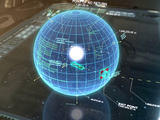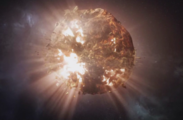Trove: Difference between revisions
From Halopedia, the Halo wiki
SLAYERHALO3 (talk | contribs) |
m (→Structure) |
||
| Line 34: | Line 34: | ||
The Shield World's main structure consisted of the outer surface, the superstructure and tunnel system inside the crust, and the inner [[Micro Dyson Sphere]], along with it's own miniaturized artificial sun. | The Shield World's main structure consisted of the outer surface, the superstructure and tunnel system inside the crust, and the inner [[Micro Dyson Sphere]], along with it's own miniaturized artificial sun. | ||
The outer surface was entirely infested with the Flood, | The outer surface was entirely infested with the Flood, as well as parts of the superstructure. Some Flood even reached to the interior of the world, but because of the larger numbers of [[Sentinels]], never managed to fully infest it. | ||
[[Image:SofInShieldWorld.png|thumb|right|250px|The Spirit of Fire inside the Shield World's superstructure.]] | [[Image:SofInShieldWorld.png|thumb|right|250px|The Spirit of Fire inside the Shield World's superstructure.]] | ||
Revision as of 11:12, April 27, 2009
Template:Ratings Template:Planet
- "But this world lies dormant. It is just a shell!"
- — The Arbiter
This Flood-controlled Shield World was a world well outside the spheres of influence of both the UNSC and the Covenant. An artificially constructed Forerunner installation, it was a variation upon the Shield World concept, originally intended to protect sentient lifeforms from the effects of the Halo Array. It also served as a port for a fleet of Forerunner Ships.
Summary
The installation's purpose was to protect lifeforms within it from the Halo Array and The Flood, and also serve as a port for a massive fleet of Forerunner ships.
Despite the fact that the Shield Worlds were created as a haven from the Array and the Flood, the external surface was heavily infested with Flood biomass, with forms of various types freely roaming across the surface. Sentinels were a rarity on the outside, but this changed within the center, where the many Forerunner constructs worked to prevent the Flood from claiming the interior as well, without much effect.[1][2]
Structure
The Shield World's main structure consisted of the outer surface, the superstructure and tunnel system inside the crust, and the inner Micro Dyson Sphere, along with it's own miniaturized artificial sun.
The outer surface was entirely infested with the Flood, as well as parts of the superstructure. Some Flood even reached to the interior of the world, but because of the larger numbers of Sentinels, never managed to fully infest it.
There were several access portals around the surface, which could be used to gain access to the Shield World. Most of them were likely hidden, for example covered under large bodies of water, such as the one The Spirit of Fire used to enter the Shield World. The access portals were seemingly automated, and controlled by an AI. Within the tunnels inside the superstructure, there was a cleansing system, which made sure that no Flood entered the interior. The cleansing system consisted of a "Cleansing Ring", which created energy fields within their diameter, which would destroy any Flood mass on a passing ship.
The inner Dyson Sphere was completely terraformed and full of plant and animal life, much like the Halo installations or The Ark. It had numerous structures and systems within it, ie. The Apex.
Like many other Forerunner installations, this Shield World possessed a Teleportation Grid.
History
- "Well, put simply, Captain, our reactor will cause the sun to go supernova, leaving nothing here but dust."
- — Ellen Anders to captain James Cutter.
In 2531, The Covenant secured a relic on Harvest, pointing them towards another UNSC colony, Arcadia. Another relic directed them to the location of the Shield World, where the Prophet of Regret and Ripa 'Moramee hoped to use the Shield World's stored Forerunner warships to crush the UNSC quickly, rather than wage the protracted war that would characterise the Human-Covenant War. To prevent this, the UNSC Spirit of Fire sacrificed its FTL Reactor to create a chain reaction in the artificial sun in the center of the Shield World, destroying it from within.
Comparison with the Onyx Installation
Unlike Onyx, which was made up of trillions of Sentinels, from which a planetary surface had formed, this world was built in a method similar to a Halo Installation, though on a much larger scale, being a hollow structure with planetary surfaces on the interior and exterior being supported by numerous pillars. Inside this is a more familiar construct of a few ship-sized portals allowing access from an opening on the outside to the interior world.
This Shield World is much like Onyx, possessing an artificial sun, though it and the entire structure are on a far smaller scale. However, unlike Onyx, it was not designed as a bomb shelter, but as some sort of harbor, shipyard or hiding place for ships, as it contains The Apex. Also, the Flood Controlled Shield World had dozens of Forerunner ships stored within it, it is unknown whether the same is true for the Onyx Installation.
While this Shield World appears to be approximately 2900 kilometers in diameter[3], Onyx's diameter is approximately 150 million kilometers, and therefore immensely larger than this shield world. [4]
Trivia
- In the cutscenes that show the surface of the Shield World, what appear to be Forerunner cities can be seen across the land.
- While in the pre-rendered cinematics the lines on the inner surface of the shield world are latitudinal, they are longitudinal in-game in the level Repairs. The appearance of the surface is also different. However, this is probably just due to in-game graphical limitations.
- According to a hologram of the Shield World in the final cinematic of Halo Wars, the distance from an exit portal to the sun in the center is 1,437,572,31 meters (1437,6 km). This makes diameter of this Micro Dyson Sphere to approximately 2875 kilometers.[5]
Gallery
- Fascination.jpg
The Apex, an installation within the Shield World.
- ShieldW Surface Closeup.png
The outer surface of the Shield World.


